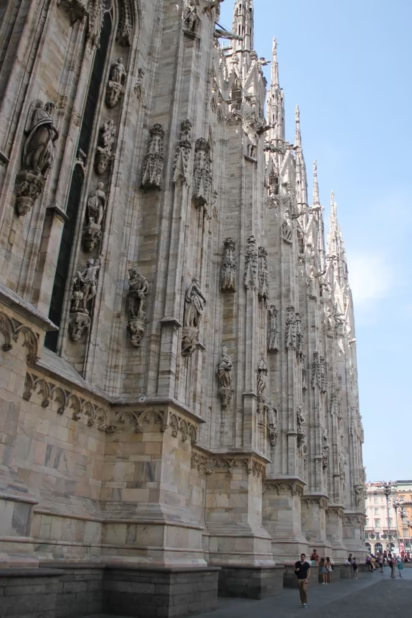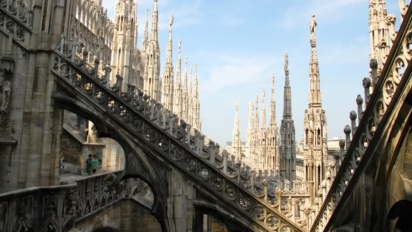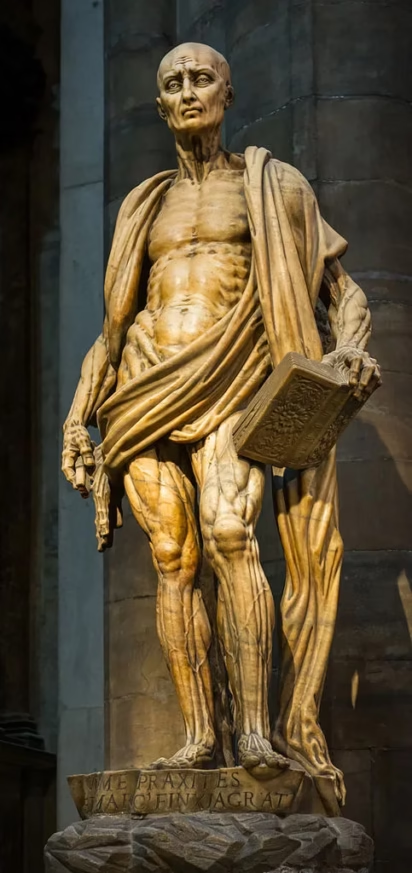The only sensible way to visit the Gothic Duomo di Milano is by buying skip-the-line tickets in advance to avoid the long queues of travelers trying to visit Milan Cathedral with its art and marvelous rooftop terraces.

The white marble Gothic facade of the cathedral in Milan makes it one of the most recognizable church exteriors in the world. The richly decorated interior is the largest Gothic church in the world but the opportunity to walk on the terraces and roof of the nave really makes visiting this famous cathedral particularly special. Admission is charged with skip-the-line time-slot online reservation tickets available to see the church inside, to go up to the roof terraces by stairs or elevator, or a combination ticket to see all the sights. Guided tours are also a good skip-the-line option to enter the Duomo without delays.
Visiting Milan Cathedral in Italy
The magnificent exterior of Milan Cathedral (Duomo di Milano, or locally Domm de Milan) with more than 2000 sculptures may be enjoyed for free but everything else at the Duomo is charged for. Information inside the church and on the roof is virtually non-existent making it sensible to either book a guided tour, an audioguide, or take a good guidebook.
Buying tickets online in advance is very much encouraged but a limited number of Duomo di Milano tickets are still sold onsite if time slots are available. Card payments are preferred but cash is still possible when buying cathedral tickets in person in Milan. The ticket office is on the south side of the church (info point) or inside the Duomo Museum.
All Milan cathedral tickets are currently with time-slot reservations but queues still form at the security checkpoints and delays may occur at busy times, as the number of visitors allowed into the church at any given time is restricted. The best time to visit the cathedral is early morning.
Guided tours use separate skip-the-line entrances to ensure quick admission. More expensive fast-track lift passes are sometimes sold in the high season and offer shorter queues for the elevator to the roof terraces and direct entrance into the Duomo afterward — often a guided tour with similar benefits may be even cheaper.
Access points for all Duomo di Milano sights are from outside the church. Entry gates are usually as follows:
- general admission to the Duomo from the west (Piazza del Duomo side),
- rooftop terraces by stairs from the meeting of the north transept and nave,
- rooftop access by lift (north transept and choir), and
- fast-track elevator from the south choir (also used by many guided tours).
Admission to the archaeological area is from inside the church near the western doors.
Milan Duomo tickets are best bought online but any leftover tickets are sold daily at the ticket shop directly across from the south transept (and in front of the Duomo Museum).
Buying Tickets for Individual Travelers to Milan Cathedral
A bewildering number of tickets and combinations are available to visit the Duomo, museum, and roof terraces of Milan Cathedral. Some fast-track tickets are only sold in the high-season summer months and the names of passes frequently change but are replaced with similar combination offers.
The following tickets are usually on offer to individual travelers visiting Milan Cathedral — buy online to save time and ensure admission on busy days:
Tickets giving access to Milan Cathedral but not the roof terraces:
- Cathedral (Duomo) — the interior of the main church only. This is the cheapest entrance ticket but is only sold on Wednesday when the museum is closed (saves only €1).
- Duomo+Museum — the interior of the church and the cathedral museum (cheapest entrance ticket on any day but Wednesday).
- Culture Pass — the interior of the church, the archaeological area, and the Duomo Museum.
Tickets giving access to Milan Cathedral and the rooftop terraces:
- Duomo and Terraces by Stairs — access to the rooftop terraces by stairs, the interior of the church, and the Duomo Museum.
- Duomo and Terraces by Lift — access to the roof terraces by elevator (but usually stairs going down), the interior of the church, and the Duomo Museum. A Fast-Track ticket has shorter queues and direct admission into the church afterward.
- Duomo Pass Lift — access to the roof terraces by elevator (usually stairs going down), the interior of the church, the archaeological area, and the Duomo Museum. A Fast Track Pass has shorter queues and direct admission into the church afterward but sometimes a guided tour offering similar benefits is cheaper.
Tickets giving access to the rooftop terraces but not the interior of the Duomo:
- Rooftop Terraces (Stairs) — Access on foot — visit the roof only via stairs (250) and no admission to the church.
- Rooftop Terraces (Lift) — Access by lift — visit the roof only by elevator (but usually descending via stairs) and no admission to the church.
Other Duomo Combination Tickets:
- Duomo+Ambrosiana — access to the rooftop by stairs, the interior of the church, the archaeological area, the Duomo Museum, as well as the Pinacoteca Ambrosiana and St Sepolcro Crypt (not always included).
- Duomo Museum — entry to the Duomo Museum and Church of San Gottardo. (The Church of St Gottardo is included in all tickets to the Duomo Museum but it is some distance away and a low priority for most foreign visitors.)
A variety of tours are also available for the church only, the church and terraces, private tours, and in combination with other sights including Da Vinci’s Last Supper and La Scala Theater.
Milan Cathedral Exterior
Milan Cathedral (Duomo di Milano) is the third-largest church in Europe (or second, or fourth, depending on who and what is counting) and the largest in Italy if the Vatican (St Peter’s Basilica) is considered an independent state.
Milan Cathedral is high gothic — a style fairly uncommon in major churches in Italy. (The cathedrals in Pisa and Siena are for example Romanesque, Florence somewhat hides its Gothic origins, while many others are Renaissance or Baroque.)
Construction of the current cathedral in Milan started in 1386 and dragged on until 1965, although the church was of course already in use much earlier. The Duomo di Milano was formally consecrated in 1572. The magnificent facade was only completed in 1810 — still, several decades before a similar feat was accomplished in Florence.
At the time of its consecration in the late 16th century, the exterior of the church was still bare and undecorated. Although at this time already well out of fashion, the exterior was decorated in the flamboyant high and later Neo-Gothic style. An incomplete Renaissance facade was removed and replaced with the white marble gothic facade on the orders of Napoleon Buonaparte, who was crowned King of Italy here in 1805. (Erroneous expectations that the French treasury would finance the work sped up construction significantly.)
The high gothic cathedral exterior decorations include nearly 2300 statues, 135 spires, nearly a hundred gargoyles, and endless architectural details. Many of the biblical scenes are fairly easy to read but many visitors are unfamiliar with events from the lives of various saints. Guides often point out the more interesting ones to educational tours making it worth eavesdropping if not taking a tour or carrying a good guidebook.
It is possible to visit the rooftop and roof terraces of Milan Cathedral for a close-up look at the forest of spires, flying buttresses, and statues. Roof visits are possible with or without a guided tour — ascent by elevator or cheaper by stairs (around 250) for magnificent views.
→ See Buy Tickets for Rooftop Visits of Milan Cathedral for more details.
Measurements of Milan Cathedral
Measured by internal area, Milan Cathedral is the second largest church in Europe (behind St Peter’s) and third largest in the world (behind the Basilica of Our Lady Aparecida in Brazil). On gross volume, it slipped behind Seville Cathedral with which it vies to the claim of being the largest Gothic church in the world.
The basic measurements of Milan Cathedral are:
- Length (external): 158.6 m (520 ft)
- Length (interior): 148.5 m (487 ft)
- Width (transept): 92 m (302 ft)
- Height (nave): 46.8 m (154 ft)
- Pillars: 52 up to 24 m high (79 ft)
- Height (external up to the Madonna’s head): 108.5 m (354 ft)
- Width of Western Face: 61.5 m (202 ft)
- Height of Western Facade: 56 (184 ft)
- Interior area: 11,700 m² (126,000 sq ft)
- Number of spires: 135
- Around 3400 sculptures, of which 2300 on the outside of the church
Visit the Interior of the Duomo di Milano
The interior of Milan Cathedral impresses mostly with its size and architecture. Although the church is filled with art, it certainly is not the artistic tour de force of many Tuscan cathedrals such as in Pisa and Siena, or Florentine churches such as Santa Croce, Santa Maria Novella, or San Lorenzo.
The basic structure of Milan Cathedral was erected between 1385 and 1520. Gothic was already going out of fashion but the techniques were well understood allowing for the vast dimensions, the high vaulting, and the huge windows. Planned Renaissance facades were never completed and baroque elements are mostly limited to interior decorations.
The church follows a fairly conventional Latin cross layout but with oversized dimensions. The nave is flanked by two aisles on each side while the transept protrudes only slightly, The rounded apse behind the choir is the oldest part of the church.
The roof is supported by 52 tall pillars 24 m high with vaulting soaring up to nearly 47 m.
The outsized dimensions and the Gothic architecture allowed for larger windows than are generally found in Italian churches — up to 144 individual scenes are possible in some windows. The 45 large windows date in parts from as early as the 14th century to the 20th century. The large painted glass windows in the apse are copies of the original stained glass windows that were destroyed during the early 19th century. However, many of the windows in the church are originals but heavily restored throughout the centuries — some original windows are on display in the Duomo Museum.
The church has virtually no information on the around a thousand sculptures and paintings inside the church — either buy a guidebook or take a tour. The most famous statue is arguably Saint Bartholomew Flayed (1562) — this work by Marco d’Agrate, a student of Leonardo da Vinci, shows the skinned saint carrying his own skin like a toga.
On the baroque altar are two sculptures of two famous local bishops: St Ambrose, the fourth-century bishop who baptized the later Saint Augustine, and St Carlo Borromeo who finally made the duomo usable in the early 16th century. His mummified body may be seen in a rock crystal coffin in the opulently decorated crypt underneath the choir.
A red light on a cross in the cupola above the altar shows where a nail from the cross of Christ’s crucifixion is kept. This relic is only shown for three days each year in mid-September.
The 1985/86 Tamburini organ is one of the largest in the world with around 16,000 pipes and 186 stops played on five manuals and pedals.
Archaeological Area of the Duomo di Milano
The archaeological area — main entrance near the rear of the church — consists of the foundation and fragments of an earlier church and baptistry that were destroyed to enable the larger new cathedral.
The area is only of moderate interest and like the artwork in the rest of the church not helped by the lack of information on what visitors see. Although worth seeing, this area is certainly not worth queueing to see.
Admission to the archaeological area is not included in the basic cathedral entrance ticket but is part of most other combination passes.
Duomo Museum

Access to the Duomo Museum (Grande Museo del Duomo di Milano) is from outside the church — it is to the south of the nave next to the ticket shop in a former royal palace. The large displays in around two dozen rooms are of items typically found in cathedral museums including the treasury, vestments, religious paraphernalia, original art and architectural detailing from the Duomo, and scale models of designs used, or rejected, during the construction of the church. Highlights include some of the original stained-glass windows — now placed lower and easier to appreciate than in the original position inside the church.
As with the artworks in the church, visitors to the museum are largely left in the dark about what is on display. Either join a tour guide or rent an audio guide.
Visitor Information for the Duomo di Milano

Opening Hours of Milan Cathedral
Most of the sights associated with the Duomo di Milano are open daily from 9:00 to 19:00 (last admissions 18:00). The cathedral may of course close for religious ceremonies but these are mostly only on high holidays inside the main church.
The exception is the Duomo Museum which is open Thursday to Tuesday from 10:00 to 19:00. The museum is closed on Wednesday (not Monday as stated in older guides) — no discounts are given on combination tickets, as these tickets and passes are generally valid for 72 hours for sights not requiring time-slot reservations.
Also, note that the opening hours for collecting and returning audio guides are sometimes shorter than for the church itself.
Tickets and Tours of Milan Cathedral
Ticket prices range from €10 for the cathedral only to over €30 for access to all sights and using the elevator to the roof. A small surcharge is added to online reservations. Only a small number of tickets are sold at the Ticket Shop of the Duomo and queues are slow-moving. Arriving without advance-purchased tickets is only sensible early mornings during quiet low-season periods.
Guided tours often include the full Duomo Pass with admission to the museum and archaeological area included even if these are not visited as part of the tour.
A variety of tours are also available for the church only, the church and terraces, private tours, and in combination with other sights including Da Vinci’s Last Supper and La Scala and city walks. Small discounts are also given if buying tickets in combination with other sights such La Scala and the Pinacoteca Ambrosiana.
All admissions to the cathedral are currently by time slot reservation tickets. However, the best time to visit Milan Cathedral is as close as possible to opening time because long lines form for the security check later in the day.
Modest dress is required for visiting the church including for both men and women no bare shoulders or shorts. Sports team t-shirts are often not allowed either, especially on days of major matches.
Food and drink are not allowed inside the church. For many sights in Italy, 500 ml is the maximum water bottle size and lately, no water at all is permitted at many top sights, especially art galleries. No luggage or large bags — book luggage storage in advance.
More Tips on Milan Sights and Tickets
- Top Leonardo da Vinci Sights and Art to See in Milan
- The Last Supper by Leonardo Da Vinci:
- How to Buy Tickets for the Last Supper,
- What to Expect when Visiting the Last Supper Museum,
- Tips on How to Buy Tickets or Book Tours for the Last Supper Museum — buy early or only guided tours are available,
- How to Get Free Tickets for The Last Supper and a step-by-step guide for booking free Sunday tickets,
- Booking Guided Tours of The Last Supper at GYG.
- Visit Chiesa di Santa Maria Delle Grazie — admission to the church next to The Last Supper Museum is free.
- Visit the Free San Maurizio Church — endless Renaissance frescoes in the “Sistine Chapel of Milan”
- Visit the Pinacoteca Ambrosiana to See Leonardo Da Vinci’s Musician Painting and the Codex Atlanticus.
- Visit the National Museum of Science and Technology Leonardo da Vinci
- Milan Duomo Complex:
- Cheapest Public Transportation to Milan Malpensa Airport (MXP).
- Book luggage storage in advance — close to transportation hubs is generally the better option.
- Book Last Supper Tours at Viator.
- Book Guided Tours for the Duomo, Last Supper, and other sights in Milano from Get Your Guide.
- Buy Admission Tickets for the Duomo and top sights in Milan from Tiqets.
- Buy Milan Guidebooks at Amazon.







